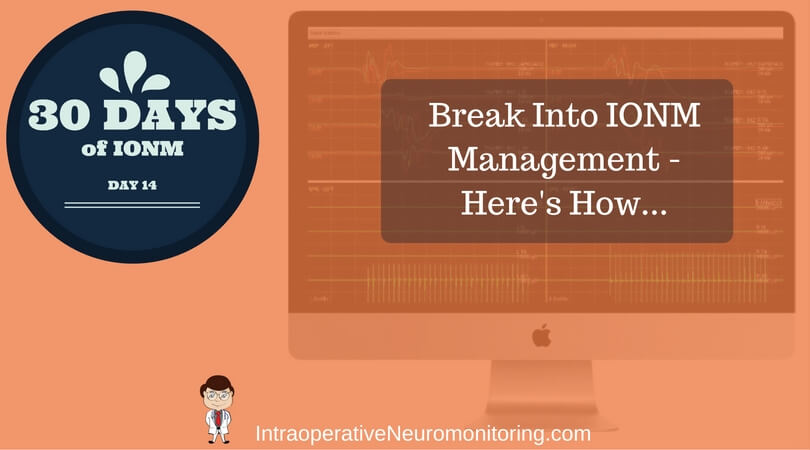IONM Manager: 7 Ways To Get A Neuromonitoring Management Position
There are far fewer neuromonitoring management positions available than there are clinicians that want them. If you’re working for a smaller contract company or in-house neuromonitoring group, you’ll find it even more difficult to become an IONM manager. That being said, I’ve noticed opportunity ready for the taking for those willing to prove they’ve got what it takes. As someone that has thought this through for my own career path, as well as someone that assess others for management positions, I’d like to share with you what I feel to be important. While I can’t promise this will be everyone’s top 7 list for neuromonitoring managers, I can make a strong assumption that it won’t be too far off.
IONM Manager In The Making
1. If you want something, get it by helping others first.
The very first rule is the most important. A manager’s success depends on the people in his or her group, so it makes sense to be known as the person dedicated to helping those around him or her succeed. Not only will the people doing the promoting notice, but so will the people on your team.
When it comes time to interview for a new opportunity, your colleagues will not only consider you a valid option for the position, they’ll want to return the favor once you are in the management position. This can go a long way if you’ll be taking over a group of peers that interviewed for the same job you just took, because sooner or later you’re going to have to ask them to do something they aren’t going to be excited about doing (staying late, traveling, working a holiday, doing a certain case, etc).
Lay that foundation of being someone that will be there for them when you weren’t necessarily asked and they’ll easily accept you in that manager role when you are.
When I first started out, I made sure to learn as much as I could from everyone I could in the company. I then jotted down the things I wish I would have learned or a different way of delivering the information. I looked up all that information and packaged it up nice and neat for the next group of people coming through the training program. So I now had what everyone else had plus my own additional material. That was a valuable asset for me to share when there was absolutely no expectation to do so.
I never asked anyone if I could be considered for a trainer position (that actually didn’t exist at that company). I took it upon myself to be over-the-top helpful and let the new hires request me as their trainer. It didn’t take long before the owners called me into the office to ask what it was I doing.
2. Don’t work to be a manager. Be a leader.
In my experience, if a manager wants his team to follow him, then s/he needs to act as more than a manager. He or she needs to take on the task of being a leader.
Managers work to get their employees to do what they did yesterday, but a little faster and a little cheaper. Leaders, on the other hand, know where they’d like to go, but understand that they can’t get there without their people or without giving those they lead the tools to make something happen.
Managers want authority; they need you to do something. Leaders take responsibility; they ask how can we best get this done. It makes things a lot easier to become recognized as a leader than a manager when you haven’t yet been placed in charge of anything. But that’s OK because most hiring managers are looking to put leaders in management roles.
I’ve seen manager’s handle their role from a position of fear. The “my-way-or-the-highway” mentality oozes insecurity. These managers cling to their position of authority because they can see characteristics in their workers that threatens it. All efforts to succeed beyond the limits set get squashed because they value their position over the anything else.
Chances are that you’ve worked for someone like this, but not for very long. There are few unfortunate tales in the IONM community of managers that are horrible bosses, yet retain their position for one reason or another. But that’s not the majority.
3. Understand what it means to be engaged as an employee. Then try to be invested.
Employee engagement is one of those HR buzzwords where we try to measure the employee that does their work at a higher level because they take pride and ownership.
We’re all given job expectations, to work 40 hours a week, maintain CNIM, get a flu shot, etc. The job description is the minimum you’re asked to do. The engaged employee is looking for more out of their work. They want to continue to grow and be productive.
The invested employee works as if they have something at stake. They might want to continue to grow, but along with the company.
They concern themselves about reducing cost, employee turnover, acquiring new business. These are all things you’ll be asked to do as a manager, so give them proof that you’re capable of fulfilling those task and are already thinking that way.
You want to be an intrapreneur. Always be searching for areas where your company can improve or opportunities that it can take advantage of. If you want to get noticed and get ahead, then you have to move beyond your job description and take on projects that will elevate both yourself and your manager.
4. Get ready to say yes.
These positions are usually pretty competitive. They don’t hand it out to the people that never stepped up to do cases, always wear their complainy-pants and worked harder to not have to work than actually do something productive.
They’re looking for a workhorse that works well to inspire others.
Every group has at least one person that does their own “case counts” every month to see who’s the most productive and who has it easier than them. Off that criteria, the management job might seem like an easy gig. Sit at home, set the schedule and then return to Netflix.
But there is a lot more to running a neuromonitoring company than just doing cases. Some of those tasks and responsibilities will fall on the neurmonitoring manager’s shoulders. If one of your IONM managers starts off a sentence with “Hey, I need some help, can you…” or “Would you mind…” or “Sorry to ask this of you, but…” then you should prepare your lips to push out the only sentence they want to hear… “yes, no problem.”

5. Get better at getting others to say yes.
If you get the ionm manager position, you’re going to have to ask people to do things they do not want to do. And not everyone is like you, working hard to improve your career and willing to do what it takes.
Hell, you’re reading a 2,000+ word article on how to work better.
It’s going to be hard to get people to say yes to your request unless you have influence. I know that sounds a lot like authority, but it isn’t.
Authority is appointed. Influence is earned.
You win influence by doing exactly what is pointed out in the first 4 points. It is a lot harder for someone to say no to another person that has already helped them out, has the best intentions on asking them to do it because they are transparent in their actions and has proven that they’ve done the same thing. Coming to the table with that background added with just a little bit of negotiation skills can go a long way to gain influence.
6. If you want a chance, take one.
There are a couple things that I highly value in a neuromonitoring manager-to-be that doesn’t really fit well on this list (like having a bias for action), but someone with initiative and ambition definitely does.
A lot of what a manager does from day-to-day is planned out on a calendar. Expectations are set and follow-ups are made to ensure they’re on the right path.
But great managers take it upon themselves to do the right thing. Again, if you don’t have the neuromonitoring manager role yet, you want to make it easy for them to envision you in it.
Do something that others aren’t, and then bring it up. Do a SWAT analysis on your area, find underserved areas in a local territory, write a useful and applicable training webinar, etc. The chances of your manager saying, “Hey, you seem smart. Can you write an article on subcortical somatosensory evoked potentials?” is a lot less likely than your ionm manager saying, “Oh, this step-by-step article on d-waves and dorsal column mapping looks awesome! Would you mind sharing it with the rest of the group? Don’t wait around for that conversation to happen, start it yourself.
7. Force their hand… be the go-to person.
Picking a manager for a territory is not an easy decision. You expect them to not only keep things running smoothly, but also improve the area.
A great manager will hold down a territory, look to create new opportunities and take on the responsibilities head on. They make life much easier for their upper management.
A poor manager can sink the ship. The number one reason why someone quits a job isn’t because they’re getting more money somewhere else, it is because they can’t work with their manager.
If you want to step in as a neuromonitoring manager, then make it hard for them to not pick you. If you’re the one that people go to when a problem pops up, you’re already well on your way to managing the area.
This wasn’t something I did, but something recognized in another SNP. A company made a switch from Xltek to Medtronic Eclipse neuromonitoring equipment. No one in the group had previous experience with the equipment and the transition went terribly without getting much support. This SNP learned program himself, wrote templates for the group and then had on-going training with the people in the area till they were up to speed.
If they had problems, it was his problem too. He had no manager role but ended up being the clinician everyone went to with questions about the equipment. It didn’t take long before that started spilling into other areas of our job. He earned his peers trust and they appreciated his efforts. He was already managing the people, which is much harder than the paperwork portion of the job. He eventually became the manager because he was the no-brainer pick.
Higher Education
You’ll notice that I don’t have “Get the credentials, get the job,” as one of my top 7. It’s not that I think education and credentials aren’t important. And I absolutely look to see if someone has a DABNM, or MBA or anything else that might be relevant to the IONM management position.
But I have to discount it as “good advice” because of the cost that can come with it. I would really think twice before going for a $100,000 MBA for a neuromonitoring manager role. Same goes with the $100,000-$200,000 it would cost to get a doctorate that would allow you to sit for the DABNM.
Your break-even point would be many, many years off. If you’re already a doctor, then absolutely sit for the DABNM.
If your company will put you through courses to earn that degree, then I’d STRONGLY consider it.
But for the rest of us without someone to take on the financial risk, there are still free or less expensive ways to gain some of what you would by going through a full program. There’s no certificate at the end of it, but if you take the actions listed above, you won’t need it to prove your worth.
Here’s a couple:
https://www.coursera.org/learn/clinical-research from University of Cape Town
https://www.coursera.org/learn/clinical-data-management from Vanderbilt
https://www.coursera.org/learn/physiology from Duke
https://www.coursera.org/learn/medical-neuroscience from Duke
https://www.coursera.org/specializations/social-media-marketing from Northwestern Universit
https://www.coursera.org/specializations/digital-marketing from U of Illinois
https://www.coursera.org/specializations/financial-management from U of Illinois
https://www.coursera.org/specializations/leading-teams from U of Michigan
https://www.coursera.org/specializations/strategic-leadership from U of Illinois
Want new articles before they get published?
Subscribe to our Awesome Newsletter.
Keep Learning
Here are some related guides and posts that you might enjoy next.
How To Have Deep Dive Neuromonitoring Conversations That Pays Off…
How To Have A Neuromonitoring Discussion One of the reasons for starting this website was to make sure I was part of the neuromonitoring conversation. It was a decision I made early in my career... and I'm glad I did. Hearing the different perspectives and experiences...
Intraoperative EMG: Referential or Bipolar?
Recording Electrodes For EMG in the Operating Room: Referential or Bipolar? If your IONM manager walked into the OR in the middle of your case, took a look at your intraoperative EMG traces and started questioning your setup, could you defend yourself? I try to do...
BAER During MVD Surgery: A New Protocol?
BAER (Brainstem Auditory Evoked Potentials) During Microvascular Decompression Surgery You might remember when I was complaining about using ABR in the operating room and how to adjust the click polarity to help obtain a more reliable BAER. But my first gripe, having...
Bye-Bye Neuromonitoring Forum
Goodbye To The Neuromonitoring Forum One area of the website that I thought had the most potential to be an asset for the IONM community was the neuromonitoring forum. But it has been several months now and it is still a complete ghost town. I'm honestly not too...
EMG Nerve Monitoring During Minimally Invasive Fusion of the Sacroiliac Joint
Minimally Invasive Fusion of the Sacroiliac Joint Using EMG Nerve Monitoring EMG nerve monitoring in lumbar surgery makes up a large percentage of cases monitored every year. Using EMG nerve monitoring during SI joint fusions seems to be less utilized, even though the...
Physical Exam Scope Of Practice For The Surgical Neurophysiologist
SNP's Performing A Physical Exam: Who Should Do It And Who Shouldn't... Before any case is monitored, all pertinent patient history, signs, symptoms, physical exam findings and diagnostics should be gathered, documented and relayed to any oversight physician that may...








0 Comments